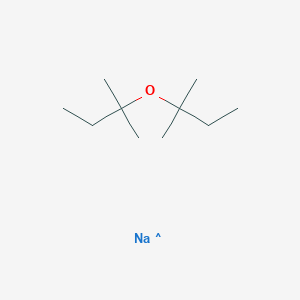
Sodium t-amyl oxide
- 専門家チームからの見積もりを受け取るには、QUICK INQUIRYをクリックしてください。
- 品質商品を競争力のある価格で提供し、研究に集中できます。
概要
説明
Sodium t-amyl oxide is a useful research compound. Its molecular formula is C10H22NaO and its molecular weight is 181.27 g/mol. The purity is usually 95%.
BenchChem offers high-quality this compound suitable for many research applications. Different packaging options are available to accommodate customers' requirements. Please inquire for more information about this compound including the price, delivery time, and more detailed information at [email protected].
科学的研究の応用
Organic Synthesis
Sodium t-amyl oxide serves as a strong base in organic reactions, facilitating the deprotonation of weak acids. This property is essential for forming carbon-carbon bonds, which are crucial in synthesizing complex organic molecules. Its role in organic synthesis can be summarized as follows:
Polymer Chemistry
In polymer chemistry, this compound is utilized to synthesize polyolefins, which are essential for producing plastics and elastomers with enhanced properties. Its applications include:
| Application | Description |
|---|---|
| Polymerization | Facilitates the polymerization process to create high-performance materials. |
| Material Properties | Enhances the mechanical and thermal properties of polymers . |
Pharmaceutical Development
This compound plays a critical role in pharmaceutical development by acting as a reagent in the synthesis of drug intermediates. Its applications include:
Analytical Chemistry
In analytical chemistry, this compound enhances the sensitivity and selectivity of assays, making it valuable for quality control processes. Its contributions include:
| Application | Description |
|---|---|
| Assay Enhancement | Improves detection limits and specificity in chemical analyses. |
| Quality Control | Used in various assays to ensure compliance with regulatory standards . |
Environmental Applications
This compound has potential applications in environmental remediation, particularly in breaking down hazardous substances through chemical reactions. Its role includes:
| Application | Description |
|---|---|
| Contaminant Remediation | Utilized to degrade pollutants in contaminated sites through chemical reactions . |
Case Study 1: Organic Synthesis
A study demonstrated the use of this compound in synthesizing complex molecules such as alkaloids and terpenes through deprotonation reactions that facilitated carbon-carbon bond formation.
Case Study 2: Pharmaceutical Development
Research highlighted this compound's effectiveness in synthesizing pharmaceutical intermediates for anti-inflammatory drugs, showcasing its importance in drug discovery and development processes.
Case Study 3: Environmental Remediation
An investigation into the use of this compound for remediating soil contaminated with heavy metals showed promising results, indicating its potential for breaking down toxic substances effectively.
特性
分子式 |
C10H22NaO |
|---|---|
分子量 |
181.27 g/mol |
InChI |
InChI=1S/C10H22O.Na/c1-7-9(3,4)11-10(5,6)8-2;/h7-8H2,1-6H3; |
InChIキー |
UIIJZQVROQHLAP-UHFFFAOYSA-N |
正規SMILES |
CCC(C)(C)OC(C)(C)CC.[Na] |
製品の起源 |
United States |
Synthesis routes and methods I
Procedure details




Synthesis routes and methods II
Procedure details





試験管内研究製品の免責事項と情報
BenchChemで提示されるすべての記事および製品情報は、情報提供を目的としています。BenchChemで購入可能な製品は、生体外研究のために特別に設計されています。生体外研究は、ラテン語の "in glass" に由来し、生物体の外で行われる実験を指します。これらの製品は医薬品または薬として分類されておらず、FDAから任何の医療状態、病気、または疾患の予防、治療、または治癒のために承認されていません。これらの製品を人間または動物に体内に導入する形態は、法律により厳格に禁止されています。これらのガイドラインに従うことは、研究と実験において法的および倫理的な基準の遵守を確実にするために重要です。













